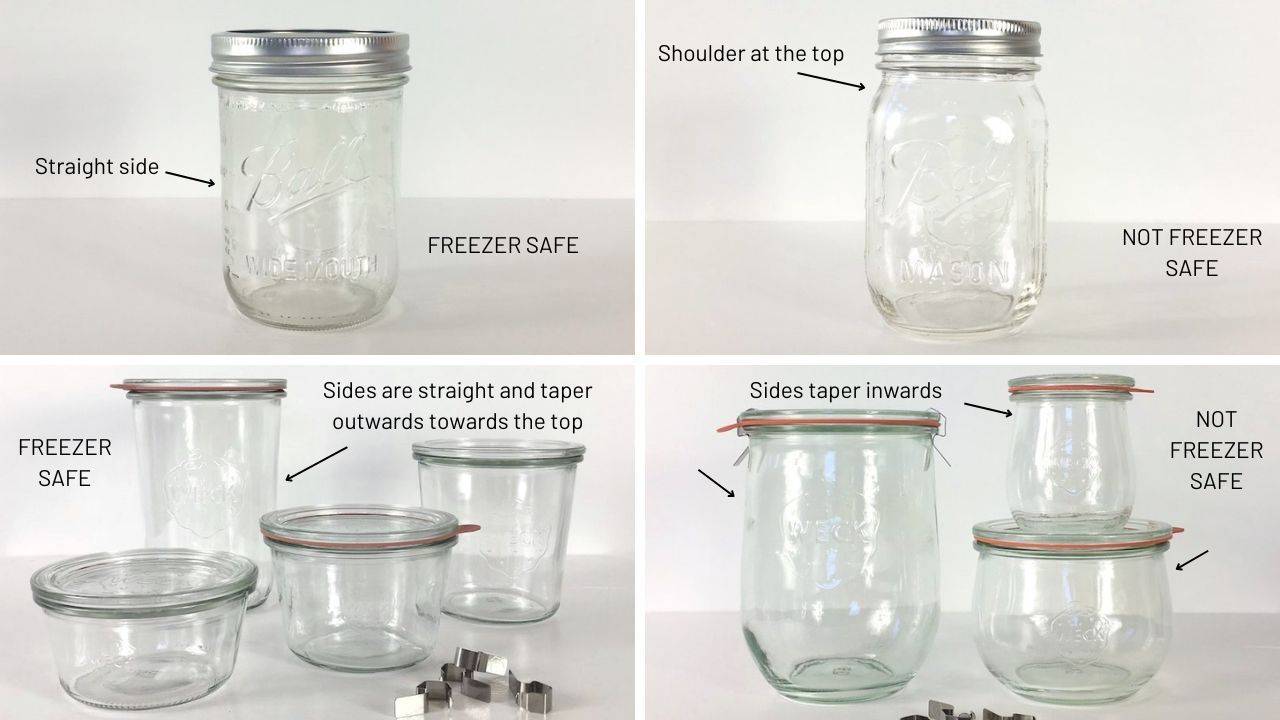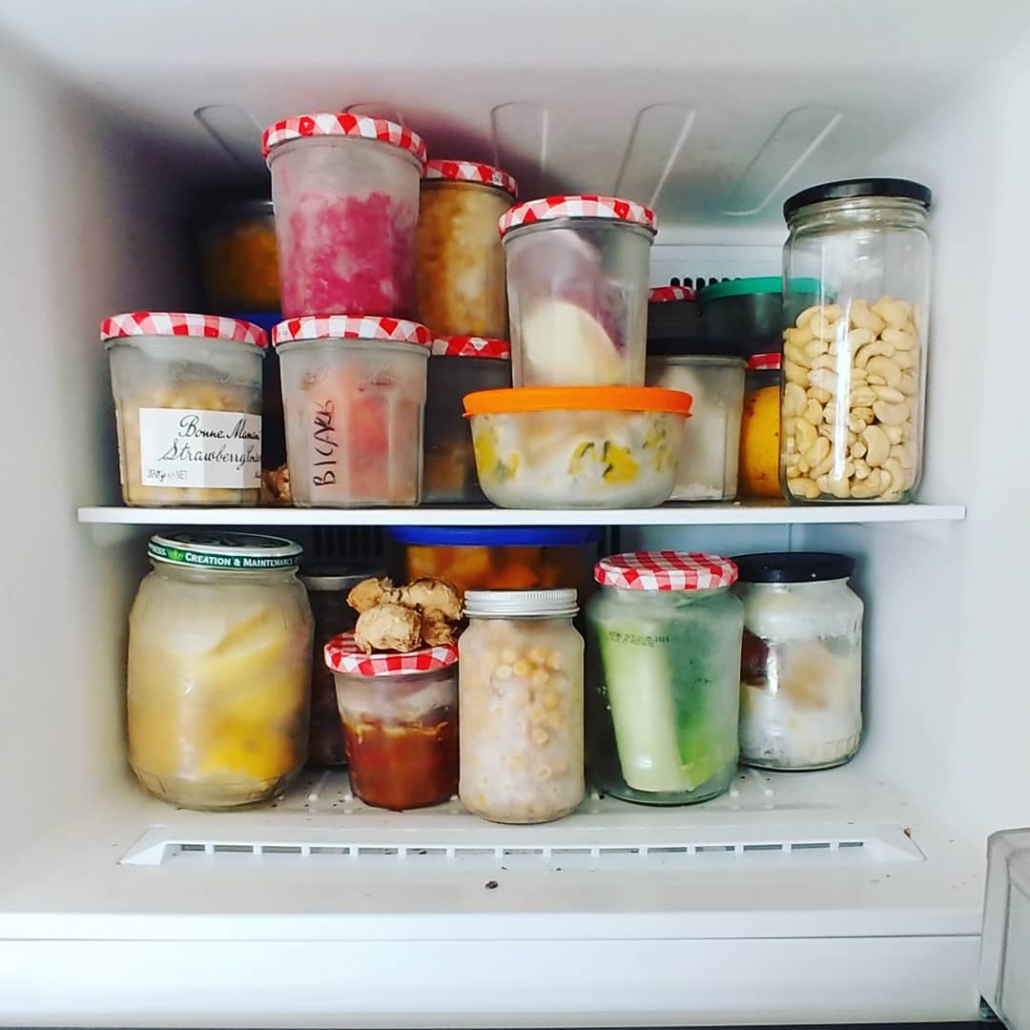Can You Put Glass in the Freezer
Glass in the freezer – is it safe? Many people feel unsure about this kitchen dilemma while storing leftovers or meal-prep dishes. Glass has many advantages over plastic – it resists odors and stains, helps the environment, and contains no petrochemicals. But glass containers might crack or break in the freezer if you don’t handle them right.
The proper techniques make all the difference in freezing glass containers safely. Glass needs special care, unlike its plastic counterparts. Stress causes glass to break, and frozen water expands inside containers with high water content. On top of that, your glass jar or container might crack without roughly 3cm of space at the top.
Freezer-safe glass isn’t a straightforward yes-or-no matter. Most glass containers work well in the freezer, but success depends on the glass type and food preparation method. To cite an instance, your frozen food needs to thaw in the fridge or at room temperature before it goes in the oven. This piece will teach you everything about freezing food safely in glass containers.

Can you put glass in the freezer?
Glass containers offer many advantages over plastic ones for freezing leftovers. Let’s tackle the question “can you put glass in the freezer?” as more people look for eco-friendly, healthier food storage options.
Why this question matters
Your choice between glass and plastic freezer containers goes beyond simple storage. Glass containers help reduce environmental waste. They don’t stain or absorb food odors because glass isn’t porous. This keeps your stored food’s quality intact.
Glass also raises fewer health concerns than plastic. Modern plastic containers no longer contain BPA (a compound that sparked health debates), but many people still worry about plastic’s safety over time.
You’ll find glass containers more durable and easier to stack, which helps organize freezer space better. Their clear walls let you see what’s inside without opening them. This cuts down on warm air exposure that leads to freezer burn.
This makes it important to know if glass can safely go in freezers, especially when you want to make healthy, eco-friendly choices in kitchen organization.
Short answer: Yes, but with conditions
Glass works great in the freezer—but you need the right kind. You can freeze glass safely if you follow specific rules to prevent breakage.
Make sure to use only freezer-safe glass containers. These containers use tempered or borosilicate glass that handles big temperature changes better than regular glass. Manufacturers make tempered glass (common in canning jars) and borosilicate glass to deal with heat stress.
The biggest risk comes from thermal shock. Glass can crack or shatter if temperatures change too fast. Here’s how to prevent this:
- Cool hot food completely before freezing (cool to room temperature, refrigerate, then freeze)
- Leave about 3cm (or ¾ inch) space at the top for liquids, which expand about 9% when frozen
- Pick wide-mouth or straight-sided jars instead of narrow-necked ones
- Keep lids slightly loose until contents freeze, especially with liquids
The container’s shape plays a big role. Wide-necked jars or ones with outward-sloping sides work better for freezing liquids. Frozen liquids need room to expand—narrow jars often crack from the pressure.
Borosilicate glass containers stand out as the best choice. They don’t have air pockets that cause shrinking during temperature changes, which makes them tough enough for regular freezer use.
People who freeze food in glass regularly report very few breaks when they follow these guidelines. Most breaks happen because of hot food going straight to the freezer, overfilled containers, or narrow-necked jars.
Glass containers make great freezer storage options if you choose and use them correctly. They’re durable, non-toxic, and resist staining, which makes them worth the extra care needed for proper freezing.

What makes glass freezer-safe
Glass isn’t just glass when it comes to freezer storage. Your containers’ molecular structure plays a significant role in determining if they’ll survive sub-zero temperatures intact. Let’s get into what makes glass freezer-safe and how you can spot containers that won’t crack under pressure.
Tempered vs. non-tempered glass
Material choice is vital for safe food storage since not all glass containers can handle freezing temperatures. Tempered glass leads the way as the gold standard for freezer use. This specialized glass goes through a heating and rapid cooling process that makes it much stronger than regular glass. The manufacturing technique creates a product that’s about four times stronger than standard glass.
Borosilicate glass is another excellent freezer-safe choice. Made with boric oxide, this material handles temperature changes exceptionally well. Scientists employ borosilicate glass in laboratory instruments because it works so well with extreme temperatures. Most borosilicate glasses work fine at temperatures as low as -40 degrees Celsius, and some types can handle down to -60 degrees Celsius.
Regular glass jars don’t do well in freezer temperatures. These non-tempered options have air pockets that cause problems when temperatures change. Regular glass might shatter with temperature differences as small as 40 degrees.
Understanding thermal shock
Thermal shock happens when glass faces a quick temperature change that makes it expand or contract unevenly. The uneven expansion creates internal stress and the glass cracks or shatters completely when that stress becomes too much.
These factors affect how vulnerable a container is to thermal shock:
- Speed of temperature change (faster changes are riskier)
- Temperature difference (bigger gaps between starting and ending temperatures increase risk)
- Glass thickness (thinner glass usually breaks easier)
- Existing damage (chips, cracks)
- Glass composition (borosilicate vs. regular glass)
The science behind thermal shock explains why hot food shouldn’t go directly into glass before freezing. Glass molecules expand when heated and contract when cooled. Quick cooling doesn’t give molecules enough time to adjust, so they contract faster than the glass structure can handle. This stress shows up as visible cracks.
Signs a container is freezer-safe
You can save food and avoid frustration by knowing how to spot freezer-safe glass containers. Manufacturer labeling is your best guide. Look for “freezer-safe” marks on packaging or the glass itself. These labels mean the product passed tests like ASTM C149, which checks thermal shock resistance.
Physical features often point to freezer-safe construction:
- Wide-mouth or straight-sided designs (stay away from narrow necks)
- Tempered glass labeling
- Borosilicate glass composition
- No metal rims or decorative features (these freeze differently)
- Thick, uniform glass construction
Properly tempered glass often has tiny bubbles you can see when holding it up to light. Freezer-safe glass usually feels heavier than regular glass containers.
Dual-purpose jars that work for both freezing and canning are reliable options. These containers are tempered specifically to handle temperature extremes, making them perfect for food preservation enthusiasts who need versatile storage.
Glass beats plastic for freezer storage because it’s non-porous and won’t absorb stains or odors. Glass containers are also free from phthalates and BPA, so nothing gets into your food. With the right selection and handling, glass containers are a durable, eco-friendly freezer storage solution that keeps food quality and safety intact.
How to freeze food in glass containers safely
Glass containers can shatter if you don’t freeze food the right way. These practical steps will help you protect both your containers and food once you’ve picked freezer-safe glass.
Cool food before freezing
Glass containers break easily from thermal shock. Hot food should never go straight into glass containers before freezing. Your containers will likely break from this sudden temperature change. Let hot foods cool down to room temperature first.
The best results come from refrigerating filled containers overnight before moving them to the freezer. The glass adjusts without stress during this slow temperature change. This method also prevents your freezer from working too hard and keeps other frozen foods from thawing partially.
Leave headspace for expansion
Frozen water expands by about 9%, so your containers need extra room. Most straight-sided glass jars need at least 1 inch of space at the top. Jars with shoulders need at least 1 inch of space below the narrowing point.
Different foods need different amounts of space:
- Fruit packed in liquid: ½-inch in wide-top pint containers; 1-inch in wide-top quart containers
- Juices: Need 1½-inches headspace in narrow jars
- Fruits and vegetables without added liquid: Only ½-inch headspace is necessary
Use wide-mouth or straight-sided jars
Your glass container’s shape plays a big role in successful freezing. Wide-mouth or straight-sided jars let frozen contents expand upward freely. This design prevents pressure points that could crack the glass.
Mason jars with straight sides work best for freezing. Half-pint mason jars and wide-mouth pint jars usually have straight sides, making them great for freezing.
Avoid overfilling and tight lids
Problems can occur even with enough headspace if lids are too tight. You might want to freeze containers first with loose lids or no lids. After 24 hours, once everything is frozen solid, you can tighten the lids.
This method gives food plenty of room to expand. Many experienced users put the lid on loosely at first, then tighten it the next day after everything freezes.
Label and date your containers
Today’s obvious frozen food might become a mystery in three months. Everything in your freezer needs a label with contents and date. You can write directly on glass containers with permanent marker (remove it later with isopropyl alcohol) or use masking tape.
Adding reheating instructions to labels helps everyone in your household prepare food easily. Labels stick better if you apply them to empty or room-temperature containers.
Glass containers are a great alternative to plastic for freezer storage if you prepare them properly. These methods keep your food fresh and prevent frustrating breakages.
How to thaw and reheat frozen glass safely
Glass containers need careful handling during thawing, just like freezing. Most glass breaks while thawing food, not during the freezing process. You need to become skilled at proper thawing and reheating techniques to protect your food and containers.
Avoid sudden temperature changes
Thermal shock breaks most glass containers. Glass expands and contracts as temperatures change. The glass moves unevenly and cracks or shatters when these changes happen faster. The glass faces intense stress when it goes from freezer-cold to room temperature quickly.
Never put frozen glass containers straight into hot water or microwave from the freezer. The glass might not reach room temperature even if the contents look thawed. This creates dangerous temperature differences. Keep frozen glass away from preheated ovens too.
Best thawing methods: fridge vs. cold water
The quickest way to thaw glass containers safely needs gradual temperature changes:
- Refrigerator method: Move frozen containers to the fridge and let them thaw overnight. Large containers like Pyrex dishes might take 1-2 days.
- Cold water method: Place sealed jars in cold water to thaw faster. Change the water every 30 minutes to keep temperature steady. Hot or warm water is not safe.
- Counter method: Containers can finish thawing at room temperature after partial fridge thawing. Keep lids loose or off.
Loose or removed lids help prevent pressure buildup as contents expand during temperature changes.
When to transfer to another dish for reheating
The safest approach is to move contents to a different container once thawed. Wait for contents to thaw 90% before moving them to heat-safe dishes for stovetop or oven heating. This removes any risk of thermal shock to the glass.
High-end glass products give you more options. Pyrex borosilicate glass handles thermal shock up to 220°C. You can move these from freezer to oven directly. All the same, putting frozen Pyrex on room-temperature baking sheets before hot ovens adds extra safety.
Food safety should guide your thawing schedule. Keep perishable foods at room temperature no longer than two hours. Bacteria grows faster in food that thaws above 40°F.
Common mistakes and how to avoid them
Glass containers can break in your freezer even when they’re freezer-safe. You can save time and avoid frustration by knowing these common mistakes before building your food storage system.
Using narrow-neck jars
Jars that narrow at the top create a big risk in the freezer. Liquid expands as it freezes and pushes up into the narrow section. This creates pressure that often breaks the glass. The design doesn’t leave any space for expansion, and the glass ends up cracking.
The best choice is straight-sided containers. Wide-mouth Mason jars, commercial sauce jars with straight sides, or dedicated freezer-safe glass containers let frozen contents expand evenly. You might need to use shouldered jars sometimes. In that case, fill them only to a point well below where they start to narrow—usually an inch below the shoulder works best.
Freezing hot food directly
Your glass containers will likely break if you put hot food straight into the freezer. Glass can only handle about 90 degrees of temperature change at once. Quick temperature shifts create uneven expansion that breaks the material.
Let hot food cool to room temperature (around 70°F) first. Then chill it in the refrigerator before moving it to the freezer. This slow cooling keeps your containers safe and preserves food quality.
Not checking for cracks or weak spots
Take a good look at your glass containers before freezing. Small hairline cracks or chips can be hard to spot but create weak points in freezing temperatures. Don’t use containers that have manufacturing defects like fused glass at the bottom.
Watch out for glass with an “offset circle” on the bottom too. These create stress points during freezing. You might not notice these small flaws until the container cracks under pressure.
Storing in the freezer door
Temperature changes happen most in your freezer’s door. The items stored there warm up a bit each time you open the door and freeze again when it closes. This is a big deal as it means that glass containers can break more easily.
Keep your glass containers toward the back or center of the freezer. The temperature stays more steady there. This spot reduces stress on the glass and helps your food stay fresh longer.
Summing all up
Glass containers give you a healthy, environmentally responsible way to store frozen food instead of using plastic. Notwithstanding that, you’ll need the right kind of glass and proper techniques to succeed. Tempered or borosilicate glass works best in the freezer, while regular glass might break under freezing temperatures.
Thermal shock poses the biggest threat to glass containers in the freezer. Your containers need slow temperature changes when you freeze and thaw food. On top of that, it’s crucial to leave enough headspace, especially when you have liquid foods that expand about 9% during freezing.
The container’s shape plays a big role too. Straight-sided jars let food expand upward instead of pushing against angled sides. Wide-mouth containers work better in the freezer than narrow-necked ones that create weak points as food freezes.
Glass containers have many advantages over plastic, even with these safety steps. They don’t absorb stains or smells, and no chemicals can seep into your food. Glass’s transparency makes organizing your freezer easier too.
These guidelines will help make glass containers your go-to choice for freezer storage. They need more careful handling than plastic, but the improved food quality and environmental benefits are worth the extra effort. Your frozen food’s taste, texture, and safety will improve – showing why glass containers belong in your freezer.
Here are some FAQs about if can you put glass in the freezer:
Is it safe to put glass in a freezer?
You can put glass in the freezer as long as it’s labeled as freezer-safe glass. Many glass containers are designed to withstand freezing temperatures, so you can put glass containers in the freezer without issues. However, you should avoid sudden temperature changes when moving glass between freezer and heat.
Can you freeze glass without it breaking?
You can put glass in the freezer overnight without breaking if it’s made of tempered or borosilicate glass designed for freezing. Regular thin glass may crack when frozen, so it’s best to only put glass Tupperware in the freezer that’s specifically marked as freezer-safe. Gradual cooling helps prevent thermal shock.
How to know if a glass is freezer safe?
Check for a freezer-safe symbol (usually a snowflake) on the glass container before you put a glass container in the freezer. Most modern glass food storage containers can go in the freezer, but delicate drinkware typically cannot. When in doubt, consult the manufacturer’s guidelines about whether can glass go in the freezer.
What glass is not freezer safe?
Thin glassware, decorative glass items, and glass with air bubbles should not be put in the freezer overnight. You should avoid putting glass containers in the freezer if they aren’t explicitly labeled as freezer-safe. Crystal glass and hand-blown glass are particularly prone to cracking under freezer conditions.
Does glass crack if frozen?
Regular glass may crack if frozen, especially when you put glass in the freezer that isn’t designed for temperature extremes. Thermal shock occurs when glass cools or heats too quickly, which is why you can put glass Tupperware in the freezer but not hot glass bakeware directly from the oven. Freezer-safe glass is less likely to crack.
Why should you not freeze glass?
You should not freeze glass that isn’t designed for it because thermal stress can cause cracking or shattering. While you can put glass containers in the freezer if they’re freezer-safe, regular glass may break when frozen due to expansion and contraction. Rapid temperature changes are especially dangerous for non-tempered glass.
How to properly freeze a glass?
To safely put glass in the freezer, first ensure it’s freezer-safe glass and leave room for liquid expansion. You can put glass containers in the freezer after cooling them to room temperature to prevent thermal shock. When removing, let frozen glass thaw slightly before washing with warm water to avoid sudden temperature changes.




